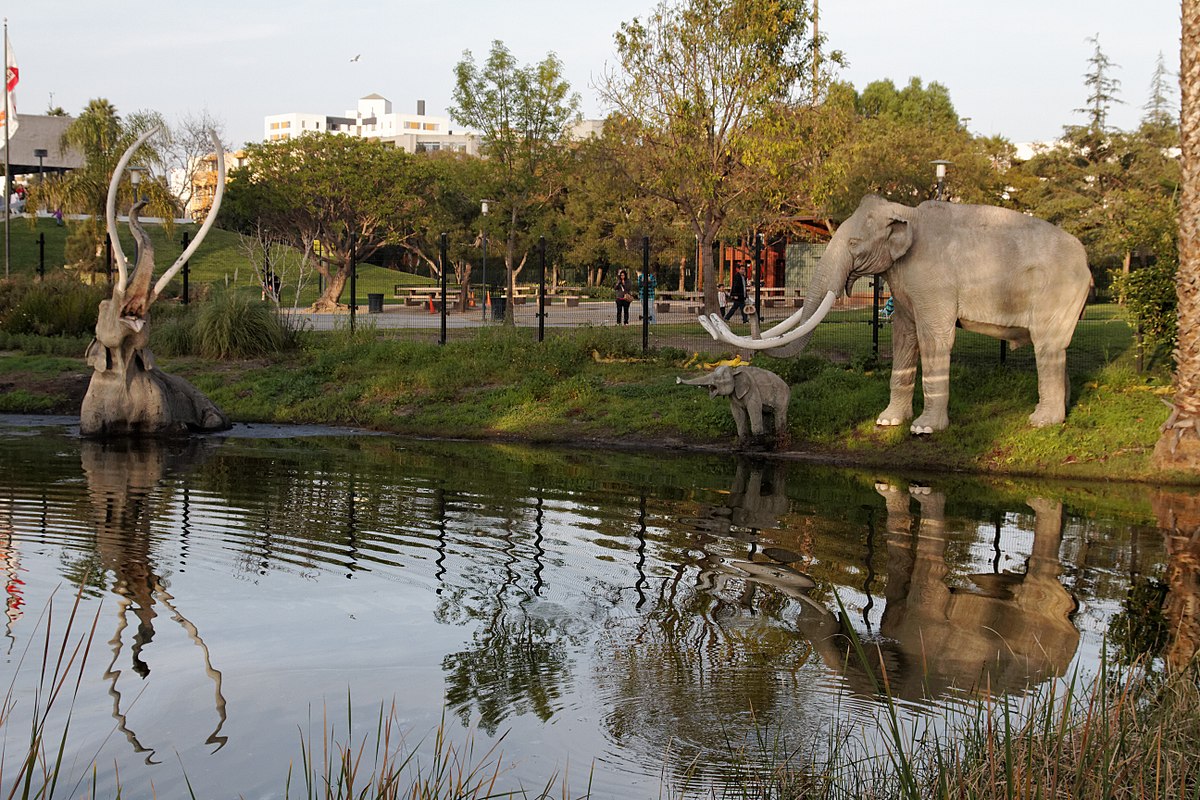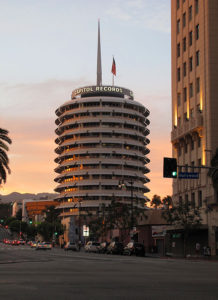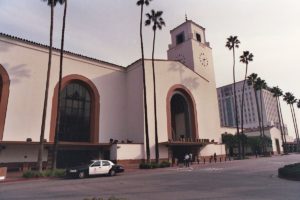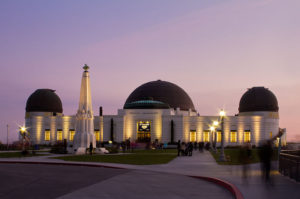La Brea Tar Pits are a group of tar pits around which Hancock Park was formed in the city of Los Angeles. Natural asphalt (also known as bitumen, pitch, or tar) has been seeping from the ground in this area for tens of thousands of years. The tar is often covered in dust, leaves, or water. Over many centuries, the tar has preserved the bones of trapped animals. The George C. Page Museum is dedicated to researching the tar pits and exhibiting specimens of the animals that perished there. The La Brea Tar Pits are a registered National Natural Landmark.
The tar pits are composed of heavy petroleum fractions called gilsonite, which seep out of the Earth as oil. In Hancock Park, crude oil seeps along the 6th Street Fault from the Salt Lake oil field, underlying much of the Fairfax District north of the park. The oil reaches the surface and forms pools, turning into asphalt as the lighter fractions of the oil biodegrade or evaporate. The asphalt typically hardens into resilient mounds. Pools and mounds can be seen in various areas of the park.
The visible tar pits today were all created by human excavations: the lake pit was originally an asphalt mine; and the other visible pits resulted from explorers who dug more than 100 sites between 1913 and 1915 in search of bones of large mammals. (Since then, these excavations have gradually been filled in by an accumulation of asphalt, dust, leaves, and water, but the tar pits they produced remain).
This seepage has been occurring for tens of thousands of years, during which the asphalt sometimes formed a deposit thick enough to trap animals. The deposit would be covered with water, dust, or leaves. Animals wandered in, got trapped, and died. Predators came in to eat the trapped animals and also got stuck. When the bones of a dead animal sink, the tar soaks into them, turning them dark brown or black. Lighter fractions of oil evaporate from the asphalt, leaving a more solid substance that then envelops the bones. Fossils of large mammals have been extracted from the tar, but the asphalt also preserves microfossils: remains of wood and plants, bones of rodents, insects, mollusks, dust, seeds, leaves, and even pollen grains. Examples of some of these are on display at the George C. Page Museum. Radiometric dating of the wood and bones preserved has given an age of 38,000 years to the oldest known material from the La Brea seeps. The pits still trap organisms today, so most of the pits are fenced to protect humans and animals.
The Portolá expedition, a group of Spanish explorers led by Gaspar de Portolá, made the first written record of the tar pits in 1769. Father Juan Crespí wrote the following:
“While crossing the basin, the explorers reported having seen some tar geysers coming out of the ground like springs; they boil until they melt, and the water runs to one side and the tar to the other. The explorers reported having found many of these springs and having seen large swamps of them, enough, they said, to caulk many vessels. We were not fortunate enough to see these tar geysers, as much as we desired; as it was some distance from the road we had to take, the Governor [Portolá] did not want us to pass by them. We baptized them as Los Volcanes de Brea.”
Harrison Rogers, who accompanied Jedediah Smith on his 1826 expedition to California, was shown a piece of the hardened asphalt while at the San Gabriel Mission, and noted in his journal: “The citizens of the country use it much for raising the roofs of their houses.” The La Brea Tar Pits and Hancock Park are situated within what was once the Mexican land grant of Rancho La Brea, now part of the urban area of Los Angeles in the Miracle Mile district. For some years, bones covered in tar were found on the Rancho La Brea property, but they were not initially recognized as fossils because the ranch had lost several animals – including horses, cattle, dogs, and even camels – whose bones are very similar to several of the fossil species. The original land grant of Rancho La Brea stipulated that the tar pits be open to the public for local people’s use. Initially, the bones from the pits were confused with the remains of pronghorn (Antilocapra americana) or cattle that had become mired.
The geologist from Union Oil, W. W. Orcutt, is credited in 1901 with the first recognition that the bones of prehistoric animals fossilized in asphalt pits at the Hancock ranch. In commemoration of Orcutt’s initial discovery, paleontologists named the La Brea coyote in his honor.
Contemporary excavations of the bones began in 1913-1915. In the 1940s and 1950s, the preparation of previously recovered large mammal bones generated great public excitement. A later study showed that the vertebrate fossil material was well preserved, with little evidence of bacterial degradation of the bone protein. They were believed to be from the last ice age, about 30,000 years ago. The fossils were re-dated to an age of 10 to 20,000 years.
“Twenty-three large tar accumulations and specimens were brought to the Page Museum. These deposits are worked under the name ‘Project 23.’ In a 2014 exploratory excavation of the subway at Miracle Mile, other prehistoric objects were unearthed.
Among the prehistoric species associated with the La Brea tar pits are the Pleistocene mammoths, dire wolves, short-faced bears, ground sloths, and the state fossil of California, the saber-toothed cat (Smilodon fatalis).
The tar pits around the world are unusual in accumulating more predators than prey. The reason for this is unknown, but one theory is that a large prey animal would die or become stuck in a tar pit, attracting predators over long distances. This predator trap would ensnare the predators along with their prey. Another theory is that dire wolves and their prey might have been trapped during a hunt. Since modern wolves hunt in packs, each prey animal could take several wolves with it. The same might be true for the saber-toothed cats known from the area.
Only remains of one human have been found, a partial skeleton of the so-called La Brea Woman, dating back about 10,000 natural years (about 9,000 radiocarbon years) BP. She was between 17 and 25 years old at the time of death and was found alongside the remains of a domestic dog, leading to the interpretation that she may have been ceremonially buried. However, later in 2016, it was determined that the dog was much more recent. Additionally, some even older fossils showed possible tool marks, indicating that humans were active in the area at that time. Saber-toothed cat bones from La Brea that showed signs of ‘artificial’ cut marks at oblique angles to the long axis of each bone were radiocarbon dated to 15,200 ± 800 B.P.
John C. Merriam from the University of California led much of the original work in this area in the early 20th century.
The La Brea tar pits have appeared in movies such as ‘1941’ (1979), ‘Bad Influence’ (1990), ‘Eye for an Eye’ (1996), ‘Land of the Lost’ (2009), ‘Last Action Hero’ (1993), ‘Miracle Mile’ (1988), and ‘Volcano’ (1997), among others. They can also be seen in the Rockstar video game ‘L.A. Noire’ (2011).”
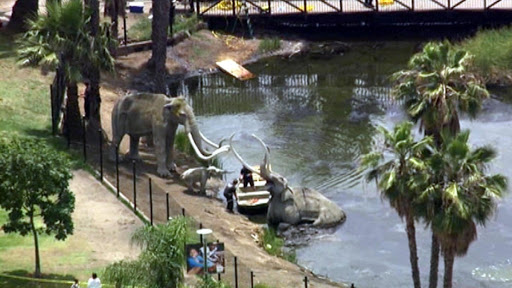
Methane gas escapes from the tar pits, causing bubbles that make the asphalt appear to boil. Asphalt and methane appear beneath the surrounding buildings and require special removal operations to prevent weakening of the buildings’ foundations. In 2007, researchers from the University of California at Riverside discovered that the bubbles were caused by forms of bacteria embedded in the natural asphalt. After consuming oil, the bacteria release methane. Around 200 to 300 species of bacteria were recently discovered here.
The George C. Page Museum of the La Brea Discoveries, part of the Los Angeles County Museum of Natural History, was built next to the tar pits in Hancock Park on Wilshire Boulevard. Construction began in 1975, and the museum opened to the public in 1977.
However, the history of the fossil museum began in 1913, when George Allan Hancock, the owner of Rancho La Brea, granted the Los Angeles County Museum of Natural History exclusive excavation rights in the tar pits for two years. In those two years, the museum was able to extract 750,000 specimens at 96 sites, ensuring that a large collection of fossils remained consolidated and available to the community. Then, in 1924, Hancock donated 23 acres to Los Angeles County with the stipulation that the county provide for the preservation of the park and the display of the fossils found there.
The museum tells the story of the tar pits and features specimens excavated from them. Visitors can walk through the park and see the tar pits. On the park grounds, there are life-sized models of prehistoric animals in or near the tar pits. Of over 100 pits, only pit 91 continues to be excavated regularly by researchers and can be seen at the pit 91 observation station. In addition to pit 91, the other ongoing excavation is called “Project 23.” Paleontologists supervise and direct the work of volunteers at both sites.
On February 18, 2009, the George C. Page Museum officially announced the 2006 discovery of 16 fossil deposits that had been removed from the ground during the construction of an underground parking lot for the Los Angeles County Museum of Art (LACMA) next to the tar pits. Among the findings are remains of a saber-toothed cat, dire wolves, bison, horses, a giant ground sloth, turtles, snails, clams, millipedes, fish, squirrels, and an American lion. An almost intact mammoth skeleton, nicknamed Zed, was also discovered; the only pieces missing are a hind leg, a vertebra, and the top of its skull, which was sheared off by the construction team in preparation for building the parking structure. These fossils were packed in boxes at the construction site and moved to an enclosure behind Pit 91, on the Page Museum property,
